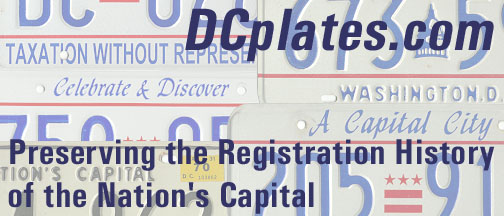
What's so special about this ordinary-looking 1974 base truck plate? Nothing about the plate itself, but it is relevant that three of the corresponding registration certificates have been preserved and kept with the plate. Shown below is the front (left) and back of the certificate that corresponds to the last renewal sticker to be applied. The serial number stamped above the name and address data, 332579, is that of the 3-31-82 sticker, and the date stamped on the back is that upon which the renewal transaction was processed (five days before the 3-31-81 registration expired). The meaning of two features on the front, the handwritten number 3383 and stamped date (almost two months into the registration year) are unknown.
|
|
||
|
|||
|
|
||
|
|||
DCplates.com welcomes contributions from license plate collectors and everyone else with an interest in plates issued during the past 102+ years, including those on the roads today, in the Nation's Capital! Please read the information about contributions on the About This Site page for details on how to contribute content to DCplates.com. |
|||
Motor vehicles operated in the District of Columbia were first required to be registered in August of 1903, but their owners were required to make or otherwise procure their own markers in order to display the registration number assigned by the city's Automobile Board. As they were in nearby states, these early homemade plates were often made of leather marked with aluminum house numbers, and kit-type metal plates were presumably also available. These early plates were used until September of 1907, when the city began to issue uniform porcelain enamel plates. These undated white-on-black plates were issued and used, with minor design variations, through the end of 1917. For 1918, dated, embossed steel plates were introduced, and new plates were issued annually through 1966 (with the exception of a few years, mostly during World War II). The final annual passenger car license plate issued in Washington, D.C. is the 1965 plate, which is black on reflective tan and marked This Web site has been prepared primarily to unravel the mysteries of the seven multi-year license plates (or baseplates) that have been issued, and revalidated with stickers, since 1966. More specifically, the focus of this site is general-issue passenger car plates; that is, plates issued to most motorists when private passenger vehicles are registered (as opposed to reserved number, optional design, and non-passenger (e.g. commercial, dealer, etc.) plates). Additional information about D.C. plate history may be found on a separate page below images of 1918-1973 plates. |
|
This page last updated on January 1, 2007 |
|
copyright 2007 Eastern Seaboard Press Information and images on this Web site may not be copied or reproduced in any manner without consent of the owner. For information, send an e-mail to admin@DCplates.com |












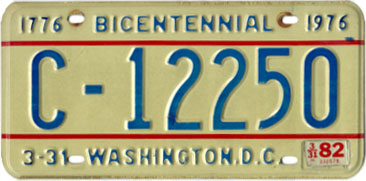
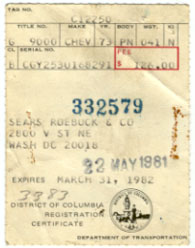
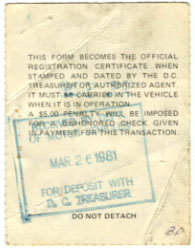
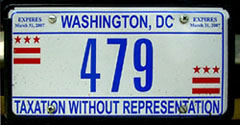 Reserved-number plates have featured distinctive designs since 2001, and this is the one that's now in use. Check our
Reserved-number plates have featured distinctive designs since 2001, and this is the one that's now in use. Check our 